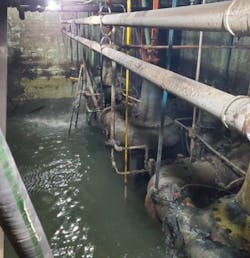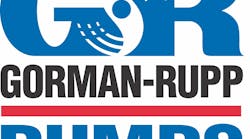When the Park Avenue East Lift Station in Mansfield, Ohio, suffered recurring flooding due to failing valves, a bigger picture goal came into view: Build a new lift station.
The lift station had 14” pumps dating back to 1961 that were still in service; failing valves flooding the station; a motor control center from 1984; and drive shaft-driven pumps that had become antiquated.
“The station had become a local legend for operators in Mansfield,” said Bob Coker, wastewater treatment plant manager for the city of Mansfield.
“Nobody really understands the troubles with that [station anymore],” Coker said, noting that previously workers would spend days rebuilding the outdated pumps at the station every week. “We started calling it a workhouse because that’s really about what it was. It was just that you knew you had to do it. You knew you had to fix it and get it running, but nobody liked it. It was going to be bad. It was going to be nasty, the worst environment.”
Located nearly equidistant to Columbus and Cleveland, Mansfield has a population of around 46,000 people. The Park Avenue Lift Station was built in 1959, and the pump manufacturer for the equipment that had been originally installed went out of business around 20 years ago. Since then, Coker said the city had worked with a local machine shop to fabricate parts for pump repair to keep them running after the manufacturer went out of business.
Park Avenue East is considered the city’s primary lift station as it handles around 70% of the community’s total flow. Shawn Beres, application sales engineer for The Craun Liebing Company, said that to address the budget, the contractor and Gorman-Rupp provided an alternate bid.
“We got together and did some field measurements after they had walked [through the site],” Beres said. “We went to this corner motor control center (MCC) type of design and asked them to do it as a bid alternative. As an alternate to the bid, they could award the station on the main lift station, but then they could choose if they wanted to spend the extra money for the brand new motor control center.”
Motor Control Center Leaps Forward
Upgrading the MCC from its original 1984 components became a massive leap forward in technology for the city and the lift station operators. But it was not without some interesting design choices due to space limitations.
Additionally, a structural beam for the entire station disrupted the intended original design, which resulted in an adjustment to a corner motor control center. The contractor essentially could not run conduit without penetrating that structural beam, so the team hit the drawing board. “The way it was originally planned, the VFDs were located in a different area and the level controls were located in a different area,” Beres said. “So what they ended up doing is taking that level control panel and placing it where the VFDs were.”
Coker said making the MCC turn a corner gave him and his team confidence in the safety of the space. But he also highlighted that the installation of the VFDs was a major step forward in addressing the wear and tear of the starts and stops for the motors and pumps.
The Right Pumps & Right Engineering
The original pumps from the 1960s presented some design challenges for the project. The design for the new station uses a horizontal shaft-driven end suction pump, but the original equipment used vertical shaft-driven end suction pumps. Beres said some of the piping had to be reworked because of this design shift.
“Gorman-Rupp was able to work with the bases that these pumps sit on and create custom bases to allow the suction lines to line up when they installed them in the field,” Beres said. “Reviewing the previous installation versus the new installation, it’s just so much cleaner with the Gorman-Rupp pumps.”
Beres noted that the station had been limited at certain amp draws due to pump limitations and that some of the older pumps had seal failures as well. With the valves also failing, operators couldn’t shut the valves off because of the seal failures, and this resulted in the flooding of the dry well. With the new pumps, that issue no longer exists.
The project used two 16” pumps and two 12” pumps designed for 27,000 gallons per minute (GPM). They first start by ramping up a 112C60-B pump to between 3,000 to 4,000 GPM, followed by bringing a second 112C60-B online to double the flow. If the flow continues and numbers hit a specified level in the wet well, this triggers a 6516A60-B pump to come online for 13,500 GPM. In the event both 6516A60-Bs are brought online, during heavy rain or large flow events, the total capacity reaches around 37.4 million gallons per day (MGD). The station was tested for 38.1 MGD, and Beres said in high water alarm applications, they found the updated station could actually reach a capacity of 51 MGD.
Reliability, Warranty & Service
One of the driving factors in the choice of Gorman-Rupp Pumps was its five-year warranty, which Beres said is “really unheard of in our business.” Because of the alternate bid, the motor control center was included in the warranty that was offered, in addition to the warranty on the pumps and load controls.
Curtis Freeman, sales application engineer for Gorman-Rupp, said the five-year warranty is applied to any packaged lift station from Gorman-Rupp. And he noted that the manufacturer aims to also provide a one-stop-shop for service for the customer, which becomes easier to manage because all pieces are provided directly by Gorman-Rupp. Regardless of what parts may need servicing, one call to them will provide a solution to the issue.
With Gorman-Rupp’s corporate headquarters located locally in Mansfield, Coker said the proximity of service response has been a large factor in providing him and his team peace of mind.
“There’s times that we’ve had to call them in at the middle of the night, and they’ve responded with no problem whatsoever,” Coker said. “Those little things really add up and it has taken us to where we are now with this major lift station rehab with Gorman-Rupp being very, very involved.”



